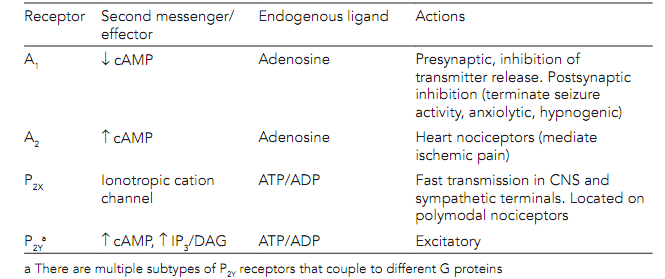Purines
Both the ATP and its catabolite adenosine are purine transmitters. The ATP is stored in synaptic vesicles and co-released with typical transmitters from postganglionic autonomic fibers and central synapses.
There are two families of receptor for ATP which is as shown in table below. The P2X receptors are ligand-gated ion channels different from the cys-loop or glutamate receptor families. They are permeable to Na+, K+, and Ca2+and exert excitatory effects. The P2Y receptors are GPCRs which are excitatory by stimulating the phospholipase C and/or adenylyl cyclase. The ATP is synaptically inactivated by an ecto-5’-nucleotidase.

The illustrations of ATP transmission include the following:
- The rapid segment of smooth muscle contraction in response to the sympathetic stimulation.
- Excitation of motor neurons and dorsal horn cells in the spinal cord by the release of ATP from primary afferents.
- In the CA3 area of the hippocampus
- The Nociceptor signaling at a number of sites (example, urinary bladder)
The Adenosine is an a classic transmitter in that it is not stored in vesicles or released in a Ca2+-dependent way. It is produced locally by enzyme-catalyzed breakdown of released ATP and ADP. The Adenosine receptors are GPCRs that modulate the cAMP. The Synaptic actions of adenosine are inactivated by the nucleoside transporter. The Adenosine transmission is as follows:
-It concludes epileptic seizures
-It protect the neurons from the oxidative stress